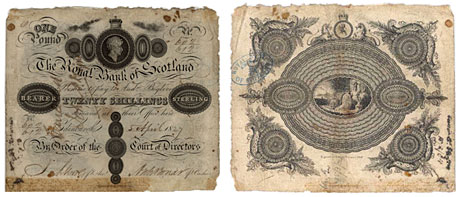£1 note of The Royal Bank of Scotland, 1827

In the 1820s notes started to be printed using steel plates. Compared to the copper plates which had gone before, steel plates were harder-wearing, longer-lasting and could be engraved with more intricate detail.
This note was The Royal Bank of Scotland's first to be printed from a steel plate. It was introduced in 1826, although this particular note dates from 1827. The work of the famous Edinburgh engraver W H Lizars, it features a much more detailed portrait (of George IV) than any of its predecessors. This was the last Royal Bank note to depict a reigning monarch until 2002, when a commemorative note marking Queen Elizabeth II's Golden Jubilee was produced.
In fact, when this note was issued in 1827, the very existence of £1 notes was a contentious matter. In 1826 the government had tried to ban all notes under £5. The proposal met little opposition in England, where regulation was much needed. The economy had suffered successive crises, and the banks had been blamed for over-issuing notes, causing instability. When the proposal was extended to Scotland, however, there was a public outcry.
Scotland relied heavily on low value notes. Scottish £1 notes had a long history, were widely used and had never caused any problems. When the proposed ban was announced, one commentator remarked, ‘the country was instantly in a blaze from one end to the other. I never saw Scotland unanimous before.' Sir Walter Scott wrote to the Edinburgh Weekly Journal under the pen-name Malachi Malagrowther, defending the £1 note. The protests were successful, and Scotland kept its £1 notes. This note is one of the first to be issued by The Royal Bank of Scotland after that victory. It was also the first British banknote to be printed on both sides.
